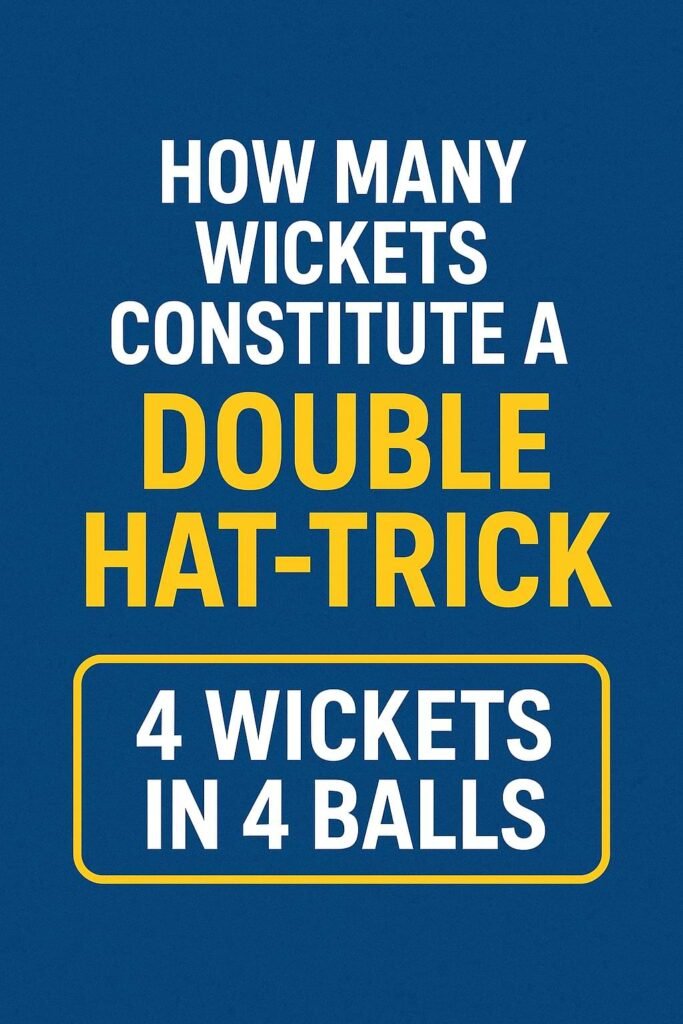In cricket, a hat-trick occurs when a bowler takes three consecutive wickets in successive deliveries. But what about a double hat-trick? Fans often wonder how many wickets are required and whether it’s officially recognized by cricket authorities. Let’s break it down.
What is a Double Hat-Trick?

It refers to when a bowler dismisses four batsmen in four consecutive deliveries. While the term “double hat-trick” is not officially used in cricket rulebooks, it is a popular expression among fans and commentators.
-
Hat-Trick = 3 consecutive wickets
-
Double Hat-Trick = 4 consecutive wickets
-
Triple Hat-Trick (rare) = 6 consecutive wickets
History of Double Hat-Trick in Cricket
The concept of the double hat-trick emerged as fans sought a term for bowlers who went beyond a standard hat-trick.
-
Lasith Malinga (Sri Lanka, 2007 World Cup): Most famous double hat-trick — 4 wickets in 4 balls vs South Africa.
-
Rashid Khan (Afghanistan, 2019): Took 4 in 4 against Ireland in a T20I.
-
Curtly Ambrose (West Indies, 1993): His 4-in-4 against Australia is often referred to as a double hat-trick moment.
Over time, the phrase became popular in cricket commentary and fan discussions, though not adopted in official cricket rulebooks.
Difference Between Hat-Trick and Double Hat-Trick
-
Hat-Trick: Achieved by taking 3 wickets in 3 balls. Officially recognized in cricket statistics.
-
Double Hat-Trick: Refers to 4 wickets in 4 balls. Not officially recorded as a separate category but celebrated by fans and media.
👉 The key difference lies in recognition. A hat-trick is part of cricket records, while a double hat-trick is an informal but widely celebrated achievement.
Is a Double Hat-Trick Official in Cricket?
Technically, cricket records only hat-tricks (three wickets in three balls). However, if a bowler takes four in four, the achievement is celebrated and often referred to as a “double hat-trick” by the media and fans.
Controversy Around the Double Hat-Trick
There is an ongoing debate in cricket circles:
-
Pro-Recognition View: Fans argue that since 3 consecutive wickets count as a hat-trick, 4 in a row should be called a double hat-trick officially.
-
Official View: Governing bodies like the ICC only recognize hat-tricks. Anything beyond is just noted as consecutive wickets, not a separate record.
This controversy fuels discussions during commentary whenever a bowler gets four in four.
Famous Double Hat-Tricks in Cricket
-
Lasith Malinga (Sri Lanka): Took four wickets in four balls against South Africa during the 2007 World Cup.
-
Rashid Khan (Afghanistan): Achieved four wickets in four deliveries against Ireland in a T20I (2019).
-
Curtly Ambrose (West Indies): Famously destroyed Australia with a four-wicket burst in 1993, often called a double hat-trick moment.
Why is a Double Hat-Trick Rare?
-
Taking three consecutive wickets is already a huge challenge.
-
Bowling four consecutive wicket-taking deliveries requires precision, pressure handling, and luck.
-
This is why only a handful of bowlers in cricket history have achieved it.
FAQs
Q1. How many wickets are in a double hat-trick?
It means four wickets in four consecutive deliveries.
Q2. Is a double hat-trick an official cricket term?
No, only a hat-trick (3 wickets in 3 balls) is official. The term is widely used informally.
Q3. Who was the first to take a double hat-trick in cricket?
Lasith Malinga became the most famous example with 4 in 4 during the 2007 World Cup.
Q4. What is a triple hat-trick?
A rare feat to take six wickets in six consecutive deliveries.
Conclusion
A double hat-trick in cricket equals four wickets in four consecutive balls. Though not officially recognized, it remains one of the most thrilling achievements for a bowler and a historic moment for fans.


